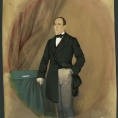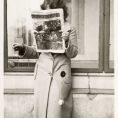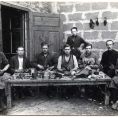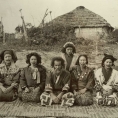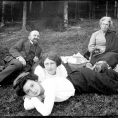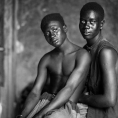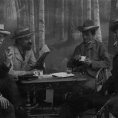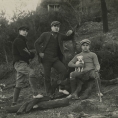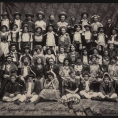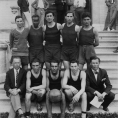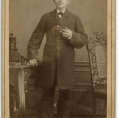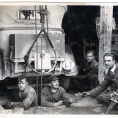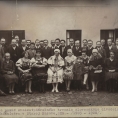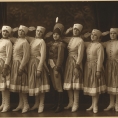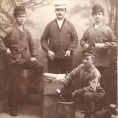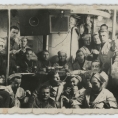Portraiture was one of the most popular genres of photography from the very early days on. Photographs were far less expensive than painted portraits and required a much reduced sitting time for the subject, enticing many people to have their image shot instead of brushed. Nevertheless, early photographic portraits show many affinities with the painterly aesthetics of that era, while at the same time reflecting the technical requirements of the photographic process: the substantial exposure time, for instance, – not to be compared with the instantaneous capturing abilities of today’s camera’s -, forced the sitter to stay immobile for a while, with a frozen facial expression. Hence the lack of relaxed smiles in the earliest examples of portrait photography. Subjects were generally seated, placed against a plain background, with the natural light of a window or a soft light resulting from reflection through mirrors covering the scene. With advancing techniques, portraits could soon be shot outside the photographer’s studio too.
In the hands of some iconic photographers, the art of the portrait was taken into new directions. Parisian writer and caricaturist Gaspard-Félix Tournachon (Nadar, 1820-1910), for instance, had a hawk’s eye for a subject’s inner and outer characteristics, and managed to capture those features with his camera. One of the early female masters of the portrait, Julia Margaret Cameron (1815-1879), used a lens with large focal length that allowed for extreme close-ups – if her subjects could remain motionless for the exposure time required… The often blurred images resulting from Cameron’s reportages, were criticized by some as inadequate representations of reality, but highly praised by the artists of her time.
Portraits quickly gained great importance in printed media as well, familiarizing readers with the faces of political leaders, popular entertainers and other celebrities. Ukrainian-born Parisian Boris Lipnitzki (1887-1971) is one of the photographers who gained fame and fortune by portraying the rich and famous: making his way through the world of arts and entertainment, he shot – among others – Josephine Baker, Jean Cocteau, Colette, Maurice Ravel, Serge Gainsbourg and Picasso, preserving the spirit of the roaring twenties till the swinging sixties. Austrian photographer Franz Hubmann (1914-2007) as well enjoyed an iconic status as well due to his portraits of artists: many of the protagonists of the Austrian and international avant-garde scene frequenting the Viennese Café Hawelka – author Franz Theodor Csokor, actor Oskar Werner and conductor Nikolaus Harnoncourt, to name but a few – were immortalized in his black-and-white creations.
Parallel to great artistic accomplishments in the portrait genre such as these, a mass market for portraits developed rapidly. Times of change in human existence in particular were captured, to provide ineffaceable memories of important life events: first steps, first school day, communion or bar mitzvah, graduation, birthday, retirement, …. These images are governed by different objectives and (quality) criteria than studio or press portraits. Not every early portrait, therefore, is a gem of originality: archives and museums all over the world hold similar series of portraits with a merely functional intent, all featuring the same poses, accessories and retouches. Even so, as an immediate translation of previous generations’ look and feel, domestic portraits have a documentary value as well, recounting in their own way the story of all our yesterdays.
Ready – set – smile!: 4 flavors of portrait photography
Generally, portrait photographers chose one of the following approaches:
- the constructionist portrait: the photographer imbeds the image in a general theme or concept: the powerful business tycoon, the smitten pair of lovers, the model family. This was the portrait type cultivated in most studio and social photography, as well as in advertising campaigns.
- the environmental portrait: the subject is shown in a specific, typical environment – at work, in his social or family circle, or enjoying leisurely pastimes. Often, the subject is engaged in a representative activity: a child taking a ride at the funfair, a mechanic working on a car, a milkman ready to take off with his horse carriage. Because of this setting in a specific and everyday context, environmental portraits often have great historical and social value and serve as primary historical sources.
- the candid portrait: subjects are photographed without their knowledge, carrying on with business as if the photographer hadn’t been there. This approach has resulted in many important images of people in the most diverse situations and places, equally contributing to our knowledge of the social and cultural flavor of days long gone.
- the creative portrait: by means of darkroom (later: digital) manipulation, certain features of the subject, the setting he/she is portrayed in, or the general style and appeal of the portrait are enhanced, accentuated or altered, adding an extra layer of meaning. Rather than conveying information about a certain day and age, these portraits reveal something about the sitter and/or the photographer that goes beyond the naked eye.

